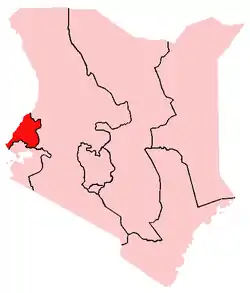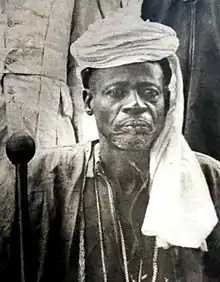Wanga Kingdom
The Wanga kingdom is a Kenyan Bantu kingdom, consisting of the Wanga tribe of the Luhya people. The Wanga kingdom was the most organized structure of government in pre-colonial Kenya politically, economically, and militarily. [1][2]
Wanga | |
|---|---|
Kingdom | |
 The Wanga Kingdom is located in Western Province, Kenya. Western Province is shaded red on this map | |
| Tribal Kingdom | |
| Seat | Mumias |
| Government | |
| • Nabongo | Peter Mumia II |
| Time zone | UTC+3 (EAT) |
Part of a series on the |
|---|
| History of Kenya |
 |
|
|
History
Precolonial history
The kingdom was founded in the 12th century by Nabongo Wanga, a descendant of the rulers of the Buganda Kingdom. The Nabongo Wanga initially settled in Nyanza Province before moving the capital to Mumias, Western Province. [3]
Nabongo Mumia and the East Africa Protectorate

Nabongo Mumia Shiundu (Nabongo Mumia) was the 17th Nabongo and became king (paramount chief) of an expansive region of Kenya at the beginning of British imposition of colonial rule in East Africa.[4][5] Nabongo Mumia is regarded as the most prowerful and well known ruler of the Wanga Kingdom, coming to power during the East Africa Protectorate in the 20th century.[6] Nabongo Mumia Shiundu's rule was heavily influenced by an alliance with Arab/Swahili slave traders and conflict with the neighbouring Luo peoples which escalated after the completion of the Uganda Railway by British colonisers.[7] Arab/Swahili slave traders formed an aliance with Wanga to raid neighboring tribes to be sold into the Atlantic slave trade including the Luo and Bukusu[6] Constant conflict led Nabongo Mumia to collaborate with the British who made him a paramount chief of an expansive region of East Africa with various chiefs reporting to him such as Chief Chabasinga who managed Jinja, Uganda, Lenan Tenai who managed the Maasai and chief Odera Akang'o who managed Luo Nyanza.[5][8]
Colony and Protectorate of Kenya

In 1926, the new Colony and Protectorate of Kenya redefined the Wanga Kingdom's territory to be the equivalent of the modern Western Provence in Kenya today. This act led to the eventual loss of any meaningful political power the Wanga Kingdom had possessed, although Nabongo Mumia remained powerful and influential until his death in 1949.[9][10][11][12]
During the colonial period, other tribes in Kenya such as the Kikuyu people, the Kamba people, the Kalenjin people under Koitalel Arap Samoei, and the Giriama people under Mekatilili Wa Menza all initially resisted British rule.[13] Due to their resistance to colonial rule the British did not extend comparable influence in colonial Kenya during the Scramble for Africa, the British alliance thus led to the prominence of the Wanga kingdom.[14][15]
The Anglo-Wanga collaboration and trade with Arab/Swahili slavers became profound at a time when most communities of north and central interior of east Africa were not affected by international trade. Other Kenyan tribes did not have any direct dealings with foreigners from the coast, and in most cases many were unwilling to welcome these foreigners into their societies.[16]
The prominence of the Wanga kingdom led to rapid territorial and political expansion by the British in the later years of the 20th century in their quest to conquer Kenya. The British, in their later conquest of the region, found the centrally organized political and social structures attractive and supported them in order to get allies in the imposition of colonial rule.[17]
In 1926, Nabongo Mumia was forced to retire by the British colonial government, he refused to take a 250 shilling monthly pension he was offered as compensation by the British until the colonial leaders threatened to arrest him. Nabongo Mumia died in 1949 and was succeeded by his son Nabongo Shitawa. Mumias was originally known as Lureko, but was renamed in Nabongo Mumia's honour.
1949 onwards
.jpg.webp)
In recent times Mumias has been dominated by the sugar cane industry, with the Mumias Sugar Company Limited being the largest sugar manufacturer in Kenya,[18][19] producing around 42% Kenyas annual sugarcane output.[20]
In 2008 the Nabongo Cultural Centre and shrine was opened, preserving cultural traditions and artifacts. The grounds also house a mausoleum containing the graves of previous Wanga kings. The opening was attended by Nabongo Peter Mumia II, Prime Minister Raila Odinga, Deputy Prime Minister Musalia Mudavadi, and ministers James Orengo and Fred Gumo.
References
- "Organised Wanga kingdom aided the British and Arabs". Daily Nation (11 August 2013).
- Standard, The (4 December 2008). "King without powers out to reclaim kingdom". The Standard (Kenya).
- "King Mumia's plan to reclaim past glory of Wanga Kingdom". Nation Media Group. Nation. December 29, 2008. Retrieved 13 January 2021.
- "Nabongo Mumia: The Story of The Wanga Noble". Google Arts & Culture. Google Arts & Culture.
- "King Mumia's plan to reclaim past glory of Wanga Kingdom". Daily Nation.
- Were, Gideon; Ochieng, William (2002). Historical Studies and Social Change in Western Kenya. East African Educational Publishers. pp. 59–62. ISBN 9789966251527.
- Meshack, Owino (2002). Africanizing Knowledge. Routledge. ISBN 9781351324403. Retrieved 13 January 2021.
- Otieno, Curtis (20 June 2018). "Meet Luo chief who jailed a colonialist". hivisasa.com.
- "The Rise and Fall of Nabongo Mumia" (PDF). Abeingo.com.
- Akwabi, Linda (13 May 2018). "African royal leaders tour Wanga kingdom". The Standard (Kenya).
- "Matungu shrine that stores the history of Wanga Kingdom". Daily Nation. 19 August 2019.
- Ochieng', William Robert (2002). Historical Studies and Social Change in Western Kenya: Essays in Memory of Professor Gideon S. Were. East African Publishers. ISBN 978-9966-25-152-7.
- "Paramount Chiefs - Kenya National Archives". Google Arts & Culture.
- Fay, Gadsden. "Further Notes on the Kamba Destocking Controversy of 1938." The International Journal of African Historical Studies, Vol. 7, No. 4 (1974). Boston University African Studies Center. pp. 681–687.
- "eLimu | Political developments and systems". learn.e-limu.org. Retrieved 9 September 2020.
- AJAYI, J.FADE; HEINEMAN, HEINEMAN; CALIFORNIA, CALIFORNIA; International committee, UNESCO. General history of Africa VI (PDF). UNESCO International committee for Drafting a General History of Africa. p. 246.
- Holzinger, Katharina; G. Kern, Florian; Kromrey, Daniela (5 December 2010). "Traditional Institutions in sub-Saharan Africa: Endangering or Promoting Stable Domestic Peace?1" (PDF). The German Foundation for Peace Research (DSF): 4–32.
- Wachira, Charles (22 October 2014). "Mumias Sugar of Kenya Idles Milling Plant for Annual Maintenance". Bloomberg News. Retrieved 20 January 2015.
- Hezron Ochiel (9 January 2015). "Sugar Prices Expected To Drop As Mumias Resumes Operations". The Standard (Kenya). Nairobi. Retrieved 20 January 2015.
- Justus Wanga (15 November 2014). "Troubled Mumias Set To Face Shareholders". Daily Nation. Nairobi. Retrieved 20 January 2015.